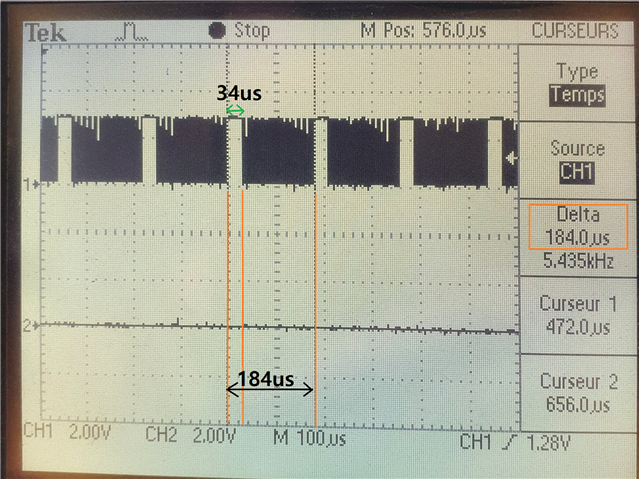Hi,
As i2c communication + computation takes 45ms in my timer interrupt that happen each 100ms and gave issue with SD, I decided to set a flag in the interrupt and execute sensors operation in the main loop.
It works but...it was estonishing slow.
Timer is properly called each 100ms. I see on scope my debug pin toggling.
But my second debug pin that should toggle in the main loop if flag is set, toogle only each 490ms ! It means that something is taking the lead in paralelle, is taking a lot of time and is not allowing me to reach the main each 100ms like I would like.
I guess Soft Device (s113 in my case) take this time. For example, communication that should take 13ms when no sd is running ( on the 45ms in total for my sensors tasks, rest is big float computation) takes 350ms ! 26 times the time it should !
After some search, i discovered Timeslot, that seems to be appropriate for perdiodic reading in real time. It should avoid radio interupt during the 45ms i need to communicate, compute and update my ble caracteristic.
I have implemented the code that blinks the pin each 100ms, it works fine and it is quiet precise even when i'm connected to my app.
Now, i have added my sensors task after the toggling of my debug pin. I have an issue because after the first byte sent via TWIM1, the program is stuck on :
while(nrfx_twim_is_busy(&my_twi)){;}
So i guess it is related to TWIM1 interrupt that should be disabled may be.
So i enable interrupt this way, but i'm still stuck on the same line:
nrf_radio_signal_callback_return_param_t * radio_callback(uint8_t signal_type)
{
ret_code_t err_code;
switch(signal_type)
{
case NRF_RADIO_CALLBACK_SIGNAL_TYPE_START:
//Start of the timeslot - set up timer interrupt
signal_callback_return_param.params.request.p_next = NULL;
signal_callback_return_param.callback_action = NRF_RADIO_SIGNAL_CALLBACK_ACTION_NONE;
NRF_TIMER0->INTENSET = TIMER_INTENSET_COMPARE0_Msk;
NRF_TIMER0->CC[0] = m_slot_length - 1000;
NVIC_EnableIRQ(TIMER0_IRQn);
//I add these lines below:
NVIC_ClearPendingIRQ(SPIM1_SPIS1_TWIM1_TWIS1_SPI1_TWI1_IRQn);
NRF_TWI1->INTENSET = TWIM_INTENSET_LASTRX_Msk|TWIM_INTENSET_LASTTX_Msk ;
NVIC_EnableIRQ(SPIM1_SPIS1_TWIM1_TWIS1_SPI1_TWI1_IRQn);
nrf_gpio_pin_toggle(DEBUG_PIN2); //flo Toggle DEBUG_PIN
Is there something else to be able to communicate on twim1 ( with dma) during a timeslot please ?
I see on Power Profile kit a big spike to 45mA each 18ms (i'mat +8dBm). I wonder if it is not the source of the delay it occurs on my sensors task executed in the main:
Do you know what it could be? It looks likes a connection packet or something to acknowledge connexion is still alive, but it' s increasing consumption a lot ! I dont't think it is advertising cause i set it to 400ms and i confirm it with nrf Connect mobil app. I'm using the basic ble_peripheral example with S113. I'm peripheral and GATT server.
Thank you!

